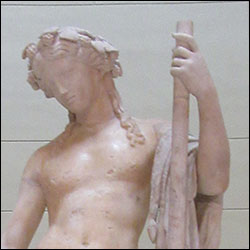
The life of Dionysos began with intrigue and disaster. Zeus was attracted to Princess Thyone of Thebes ... he, of course, found a way to seduce her. Thyone was part of the royal household as the daughter of King Kadmos and Queen Harmonia ... Kadmos was favored by Apollon and Harmonia was the daughter of Aphrodite, goddess of love, and Ares, god of war.
Zeus's attraction to Thyone did not escape the notice of his sister-wife, Hera. The vengeful goddess dared not interfere overtly with Zeus's affairs, but she was a master of subtlety. The deception of Thyone by Hera was twofold ... Hera first enchanted the maiden and prompted her to pray to Zeus for eternal life ... secondly, Hera induced Thyone to ask Zeus for the ability to see him in all his immortal glory. Zeus agreed to Thyone's requests but when he revealed his true nature of thunder and lightning, she was consumed in flames ... before she was destroyed, Zeus transformed her into an immortal being ... she assumed the name of Semele.
Zeus's son Hermes rescued Thyone's premature child from the conflagration that consumed Thyone's mortal body and gave the babe to a woman named Makris, daughter of Aristaios, on the island of Euboia. Makris did what she could to sooth the child, but Hera was quick to realize what had happened ... she drove Makris from her home. Zeus took the infant from Makris and sewed it into his thigh so it could have his protection.
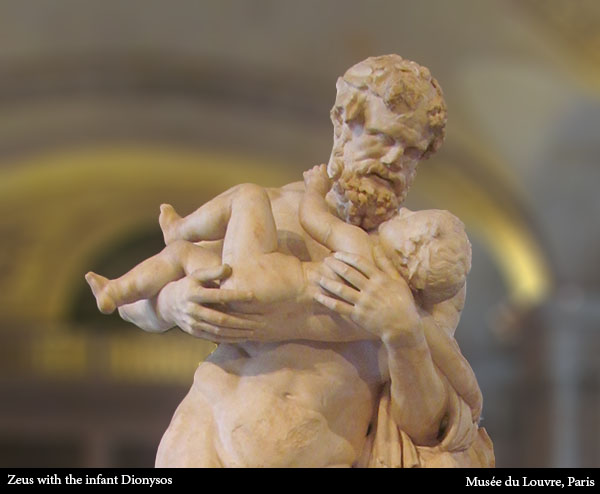
The name, Dionysos, literally means God of Nysos, i.e. Dio = God and Nysos = Mount Nysos. His other name, Bakkhos, came later and seems to be a variation of the word Iakkhos, meaning Shout. Written records of the name Dionysos can be traced to the island of Keos as early as the fifteenth century BCE but despite his scarce mention in the Iliad and the Odyssey, the worship of Dionysos probably dates back to the Mykenaian Era, which predates the Trojan War. This would mean that Dionysos was a relative latecomer to the Olympic pantheon, but he was quickly assimilated into the rites of all the Immortals.
There are several versions to the story of how Dionysos became the god of Mount Nysos:
1) When Dionysos emerged from Zeus's thigh he was entrusted to Thyone's sister, Ino. Hera again vented her anger towards Dionysos and compelled Ino's husband Athamas to murder his son, Learkhos. To escape Hera, Ino leapt into the sea with her son, Melikertes. Dionysos was then entrusted to the Nymphs of Mount Nysos to be reared;
2) Dionysos emerged from Zeus's thigh on Mount Nysos and was nurtured by the mountain Nymphs. Mount Nysos, according to the Homeric Hymn to Dionysos, is in Phoinikia, near the streams of Aegyptus (the Nile) but according to the historian Herodotos, Mount Nysos was in Upper Egypt in Aithiopia. The locations of Upper and Lower Egypt are reckoned by the course of the Nile River. Thus Upper Egypt is the southern portion of Egypt and Lower Egypt is where the Nile empties into the Mediterranean Sea.
The assent of Dionysos to Mount Olympos was gradual. He traveled the known world gathering followers and subjugating nonbelievers. To his followers, he appeared as a dapper young man, perhaps effeminate. To his enemies, he dressed in war-gear draped with panther skins. In that guise, he meted out harsh judgments to the impious. He planted grapevines as he traveled and taught people how to make wine. In places unsuitable for grapevines, such as the arid territory of Egypt, he introduced a drink made from barley named zythos, which is what we would call beer.
Dionysos ventured as far east as India and after three years, returned to Thebes on the back of an elephant carrying his plunder. His return to Greek soil was tumultuous. He was alternately welcomed and rejected as he instituted his rites and dispensed wine. Those who welcomed him quickly adopted his rituals but those who rejected him were punished with physical afflictions, transformed into animals or reduced to madness.
As time passed, the worship of Dionysos became central to the religious activities of the ancient Greeks. The basis for the worship of Dionysos was the drinking of wine as a sacrament. Many Greeks used wine to promote frivolity and forget the cares of the day. Some Greeks abused the sacrament and simply used it as an excuse to indulge in unbridled lascivious behavior. This seems to be the same dichotomy of behavior induced by wine (or any alcoholic beverage) today, some use it and some abuse it.
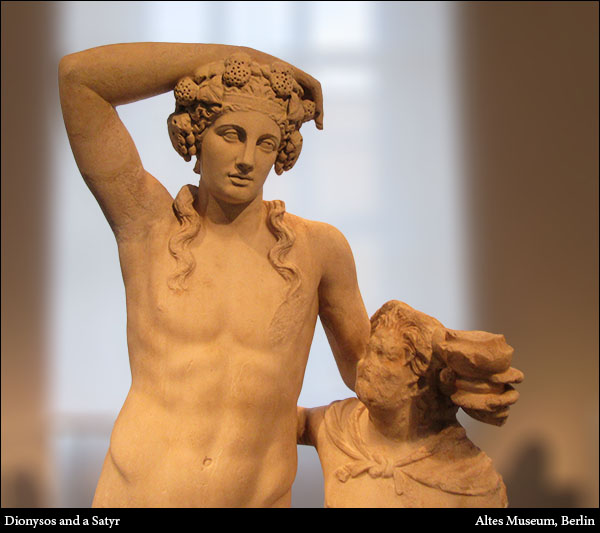
Dionysos and his followers were distinctive in their attire and demeanor. Dionysos was almost always in the company of Nymphs, Satyrs, and Maenads as they capered through the forests and city streets. There were several distinctive items carried and worn by Dionysos and his followers.
Thyrsus—A wand with ivy entwined around the staff and a pinecone and vine leaves mounted on the top.
Krotalons—Musical rattles consisting of tuned lengths of bone or hardwood suspended at one end from a hand-held frame and used by dancers in the worship of Dionysos. The same sort of musical rattles were used in the worship of the Asian goddess, Kybele. The krotalons were used by Herakles to frighten away the Stymphalian Birds during his Sixth Labor.
Krokotos—A saffron colored robe worn by Dionysos and his followers.
Nebris—A robe made of fawn skin worn by Dionysos and his followers.
Maenads—The female companions of Dionysos, usually represented as frenzied revelers.
Satyrs—A class of woodland deities who were part human, part horse and sometimes part goat. Satyrs were frequent companions of Dionysos and noted for their riotous and lascivious behavior.
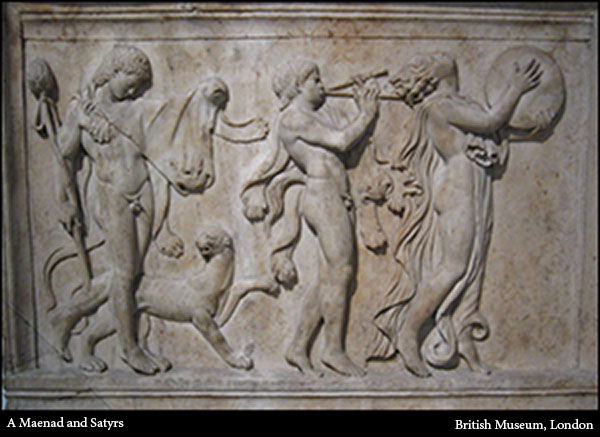
The above image shows a Maenad leading two young men in an ecstatic procession. The last young man holds a thyrsus as a panther frolics at his feet.
Silenos was the foster father, teacher and companion of Dionysos. Silenos was a forest Spirit but often, and incorrectly, thought of as an elderly Satyr. Silenos was usually represented as a drunken old man but sometimes depicted with the legs and ears of a horse.
Silenos often accompanied Dionysos as he traveled but also had his own rascally adventures. Midas was the infamous king of Phrygia in Asia Minor who was cursed with the Golden Touch. While Midas was entertaining Silenos, he was granted a wish by the wily Spirit. Midas foolishly wished that everything he touched be turned to gold. When Midas found that his food was also turned to gold, he renounced the wish that Silenos had inflicted upon him. By washing his hands in the river Paktolos, Midas lost his golden touch. The river Paktolos has had golden sand ever since.
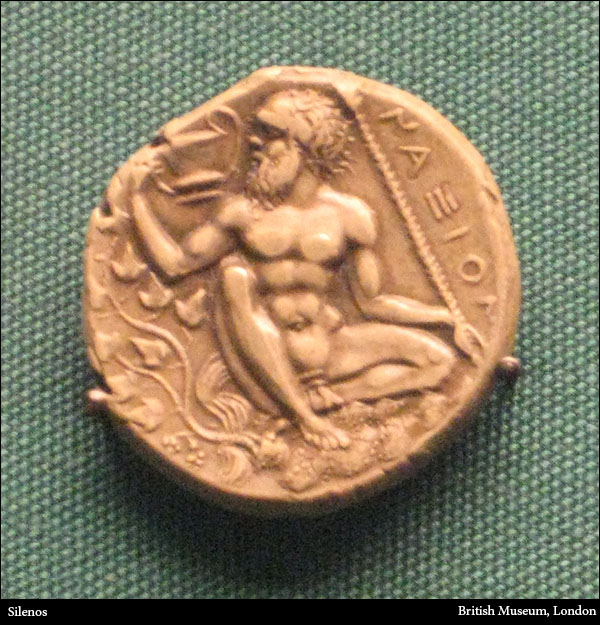
A silver coin with the image of Silenos from the island of Naxos circa 410 BCE.
It should not be surprising that Aphrodite (goddess of love) was a companion of Dionysos. She and Dionysos had a son named Priapos who was a rural god of gardens and vineyards. Inheriting virility from his father, Priapos was a god of the male procreative power.
Euios (Evius)—A name for Bakkhos taken from the cry "Evoi" used by his worshipers.
Pyrigenes—A name literally meaning Born of Fire, denoting Dionysos's birth amid thunder and fiery lightning.
Bromios—A name for Dionysos recalling the thunder (bromos) that accompanied his birth.
Thriambos—A name given to Dionysos for the triumph (thriambos) celebrated when he returned to Greece from India.
Iakkhos—A name for Bakkhos as well as the name of hymns sung in his honor.
Lyaios—A name for Bakkhos as The Deliverer.
Lenaeos—A name for Dionysos because he introduced the practice of treading on grapes in a tub (lenos) to make wine.
Mitephoros—A name denoting the woven headband Dionysos invented to prevent hangovers. It was credited as being the precursor to the diadem worn by kings.
Dimetor—A name used by those who believed that there were two sons of Zeus named Dionysos. The two Dionysi were of one father and two mothers and separated by an indeterminate number of years.
Orotalt—The name by which the Arabians called Dionysos. According to the historian Herodotos, the Arabians only worshiped Aphrodite (goddess of love) and Dionysos. Aphrodite was worshiped under the name Alilat, i.e. The Goddess. Herodotos mentioned this connection between Dionysos and Orotalt when he was relating the pledge of peace the Persian king Cambyses made to the Arabians so they would assist the Persian army by providing water for crossing the desert of the Sinai Peninsula and thus allowing the Persians to attack King Amasis of Egypt. The two men making the pledge would allow a third man to cut their hands and smear their blood on seven stones, all the while calling on Orotalt (Dionysos) and Alilat (Aphrodite) to witness the pledge. Herodotos said Orotalt and Alilat were the only two Immortals the Arabians honored and that the Arab men would imitate Dionysos and "cut their hair in a circle round, shaving away the hair of the temples."
Osiris—Osiris is the Greek rendering of the name of the Egyptian god of the dead, Asar. According to the historian Herodotos, the Egyptian god Osiris was somehow equated with Dionysos. Herodotos stated that the only two gods worshiped throughout Egypt were Isis (Ast) and Osiris (Asar) but exactly how Osiris and Dionysos are similar or equal was not explained.
Sakae Sabazius—An Asian god associated with Dionysos and worshiped mainly by women.
Traveling through Attica, Dionysos was entertained by a kindly man named Ikarios. As a reward for the hospitality, Dionysos gave Ikarios the gift of wine, which was unknown to mortal men at that time. When Ikarios shared the wine with his neighbors, they became drunk, murdered Ikarios and hid his body. Knowing something was wrong, Ikarios's daughter Erigone used her faithful dog Maira to search for her father. When Erigone found Ikarios's dead body she was so overwhelmed with sadness she committed suicide by hanging herself from a tree. With Erigone and Ikarios both dead, the faithful dog Maira was placed in the sky as the brightest star and thereafter called the Dog Star.
Another tragic consequence from the introduction of wine to mortals concerned a man named Dryas. Dryas was the son of the king of Thrace and was killed by his father after Dionysos drove the old king mad. In his drunken state, the confused king mistook his son Dryas for a grape vine and killed him.
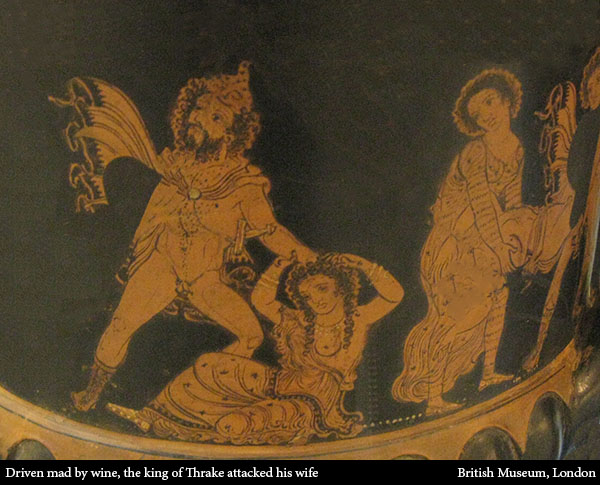
Hephaistos was the lame son of Hera who was thrown from Mount Olympos by either Hera or Zeus, depending on which story you choose to believe. Regardless, Hephaistos was unwelcome on Olympos so he honed his skills as a master artificer in secret. Hephaistos grew to manhood and Dionysos was sent to find him and bring him to Mount Olympos. Hephaistos was unwilling to join the other Immortals so Dionysos subdued him with wine and transported him to Olympos on a donkey. Hephaistos was quickly welcomed by the Olympians because of his phenomenal inventions and masterful building skills.
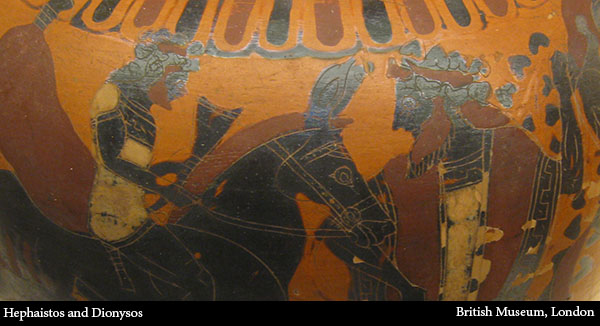
Princess Ariadne was the daughter of King Minos and Queen Pasiphae of the island of Krete. She is best known for her tragic love affair with the Athenian hero, Theseus. However, her ultimate fate was intertwined with that of Dionysos.
Ariadne met Theseus when he went to Krete to end a deadly feud between King Aigeus of Athens and King Minos of Krete. King Minos's son Androgeos went to the first Panathenaic Games in Athens and attracted the ire of Theseus's father King Aigeus by winning all the prizes ... Aigeus had Androgeos killed.
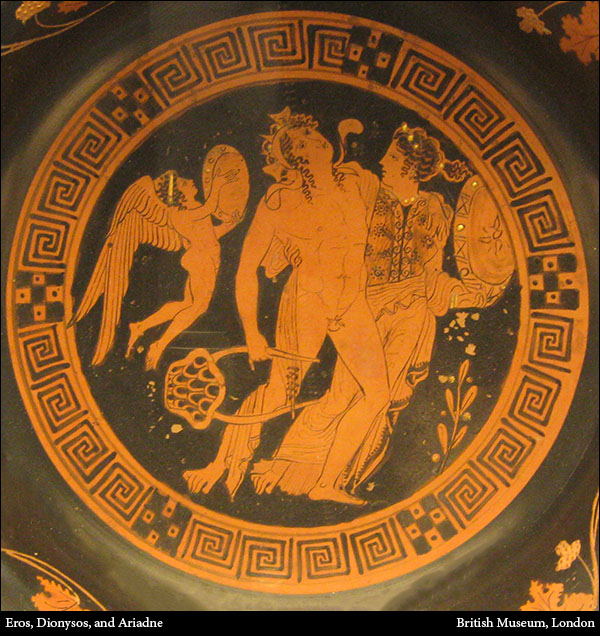
Minos waged war on Athens to avenge the death of his son. Minos was not the only one offended by the murder of Androgeos ... the Immortals punished the Athenians too. The Athenians not only had to fight the war with Krete, the Immortals inflicted them with a drought ... the war, coupled with the shortage of food and water, made Athens a desperate city.
Peace and prosperity were finally restored with the promise that Athens would send seven young men and seven young women every nine years to King Minos as a tribute. A condition of the agreement was that the Athenians should furnish the ship carrying no warlike weapons, and that the youths should sail to Krete accompanied by King Minos.
The Athenian youths were placed in a labyrinth where the Minotaur would hunt them down and savagely kill them. The tradition continued until Theseus voluntarily entered the labyrinth and killed the Minotaur. Theseus was given a spool of thread by Ariadne which he unwound as he entered the labyrinth and was thus able to retrace his steps and escape the intricate maze.
After the ordeal with the Minotaur, Theseus and Ariadne fled Krete. According to the Odyssey by Homer, Odysseus encountered the "shade" of Ariadne when he evoked the spirits of the Underworld. Theseus was taking Ariadne to Athens but abandoned her on the island of Dia where Dionysos "bore witness against her."
At that point, the final fate of Ariadne becomes unclear but there are several compelling stories involving Dionysos:
1) Theseus abandoned Ariadne for a woman named Aigle. Ariadne was then taken to the island of Naxos where she married a priest of Dionysos named Oenarus;
2) Dionysos found Ariadne on the island of Dia and married her ... Zeus made Ariadne immortal and un-ageing;
3) There were two women named Ariadne stranded on the island of Naxos. One was married to Dionysos and her passing was celebrated with gaiety. The other Ariadne had been abandoned by Theseus and her passing was commemorated with sorrow and lamentation.
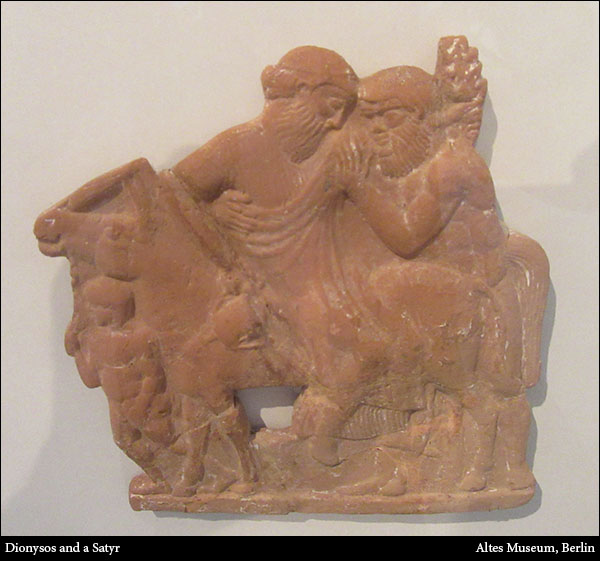
Lykurgos was the son of a man named Dryas. The story of Lykurgos is an object lesson as to why mortal men should not do battle with the Immortals. While Dionysos was still a child, Lykurgos raged down the slopes of Mount Nysos with an ox-goad and scourged the Nymphs who cared for young Dionysos. The Nymphs dropped their wands to the ground and fled for their lives. Dionysos was so terrified he jumped into the sea to escape the murderous brute. The goddess Thetis saved Dionysos, but the assault was not unnoticed or unforgiven by the other Immortals. Zeus blinded Lykurgos as a just punishment but Lykurgos did not live long with his affliction because all the Immortals hated him for what he had done to Dionysos.
Aura was a companion of Artemis, goddess of the hunt, who bore twins to Dionysos. Zeus changed Aura into a spring because she, in a fit of madness, killed one of Dionysos's children.
King Proteus of Tiryns had three daughters—Lysippe, Iphinoe and Iphianassa. The girls refused to receive the rites of Dionysos and denied the divinity of Hera. For this sacrilege, they were driven mad and believed that they had been turned into cows. They were finally cured by a seer named Melampous who could understand the speech of animals.
A story from Roman times (Ovid and Antoninus Liberalis) related an event supposedly taken from early Greek literature. The daughters of King Minyas refused to participate in the rites of Dionysos ... furthermore, they mocked Dionysos, his worshipers and other gods and goddesses. For their effrontery, Dionysos either: 1) turned them into cannibals or 2) transformed them into bats.
Eurytos was one of the huge monsters collectively known as the Giants ... the Giants were the children of Ge (Earth) engendered by the blood of Ouranos (Heavens) after he had been emasculated by his son, Kronos..
The Giants waged an unsuccessful war on the Olympians and were severely punished after their defeat. The poet Hesiod stated that the Giants were banished to the Underworld, but Apollodorus of Athens clearly described the brutal death of the Giants.
The Giants were mostly human in form, but their bodies were massive, and they were seemingly invincible. They had long drooping locks on their heads and chins ... their feet had scales like a dragon or serpent. Whether they actually had the feet of dragons or whether they were simply scaled was a point of contention among several of the ancient authors. The traveler-historian Pausanias disputed the fact that the Giants literally had dragon feet, but ancient artwork generally represented the Giants with serpent-like feet. The origin of the Giants was either Phlegrae or Pallene, but it has been suggested that the two names represent the same place.
The Immortals were given an oracle that stated that the Giants could not be killed by a god or goddess, so they decided to enlist the aid of Herakles to do the actual killing. When Ge learned of the oracle, she began the preparation of a drug that would protect her awful children, but Zeus culled a cunning brew of his own that would make the Giants vulnerable to the wrath of the Immortals. In order to have the time necessary for the creation of the drug, Zeus forbade Eos (Dawn), Selene (Moon) and Helios (Sun) to shine until his task was complete. The goddess Athene summoned Herakles and the war against the Giants began. Eurytos was killed by Dionysos with a thyrsus, i.e. his wand. The other giants met a similar fate at the hands of Herakles and other Immortals.
The Dionysia were orgiastic and dramatic festivals held periodically in honor of Dionysos especially the celebrations held in Attica. The public performances of the Dionysia served as the foundations of later Greek comedy and tragedy.
The Great Dionysia (City Dionysia) was a festival of Athens in honor of Dionysos that was celebrated in the early Spring and notable for the performance of dithyrambs (a wild and irregular choral song or chant), tragedies, comedies, and Satyr plays (ribald dramas with a chorus of Satyrs).
The Lesser Dionysia (Rural Dionysia) was a festival consisting of series of wine feasts, processions, and dramatic performances in honor of Dionysos. The Lesser Dionysia was held in the second half of the month of Poseideion, which was the sixth month of the Attic year and would approximately correspond to the third week of November to the third week of December of our calendar.
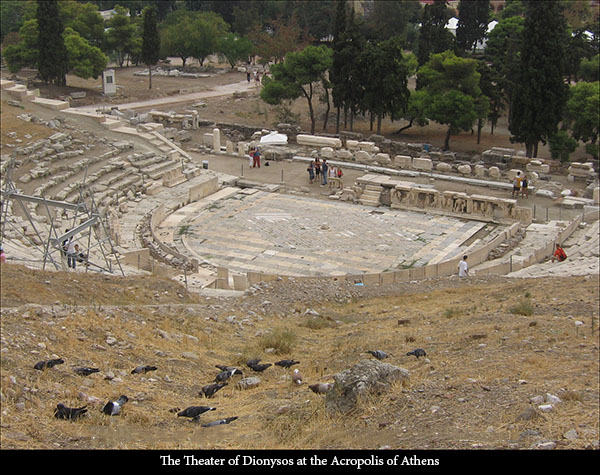
The Haloa was a festival of Attica where women would dance around a giant phallus in honor of Dionysos and Demeter, goddess of the harvest. The Haloa was a winter festival held on the twenty-sixth day of the month of Poseideion, which would be in mid-December by our calendar.
The Lenaea was an Athenian festival in honor of Bakkhos that featured dramatic contests. The Lenaea was held in the month of Gamelion and was a four-day festival from the twelfth to the fifteenth day of the month ... approximately the second week of January by our calendar.
The Anthesteria—Feast of Flowers—was an Athenian festival of Dionysos. The Anthesteria was a winter festival was celebrated in the Athenian month of Anthesterion ... the month of February by our calendar.
The Bakkhanalia was a festival in honor of Bakkhos. The celebration was fueled by wine, which incited frenzy in the participants. The Bakkhanalia was banned by the Romans in the second century BCE because of the depraved and wanton nature of the festivities.
The Theoinia was a local form of the Dionysia celebrated by feasts and sacrifices at small shrines.
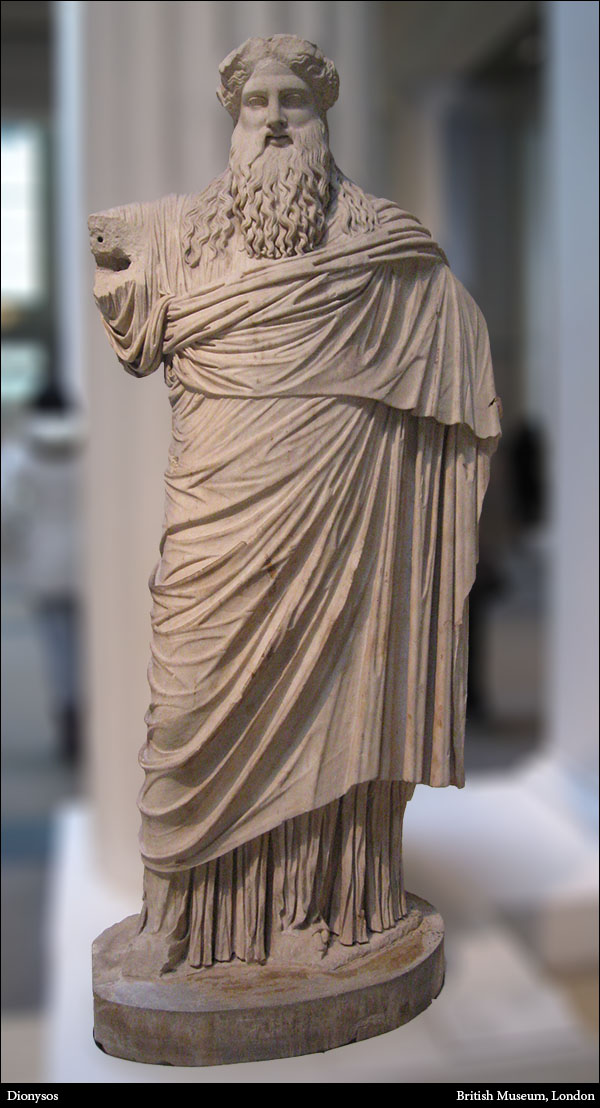
The above statue is of a mature Dionysos wearing an ivy wreath. This is Roman copy (circa 40-60 BCE) of a Greek original (circa 350-325 BCE).
The Iliad
The Odyssey
Theogony
Works and Days
Catalogues of Women and Eoiae
Catalogue of Women
Shield of Herakles
Hymn to Dionysos I
Hymn to Dionysos VII
Hymn to Dionysos XXVI
Hymn to Pan XIX
Odes of Pindar
The Histories by Herodotos
The Argonautika by Apollonius of Rhodes
Library of History by Diodorus of Sicily
Description of Greece by Pausanias